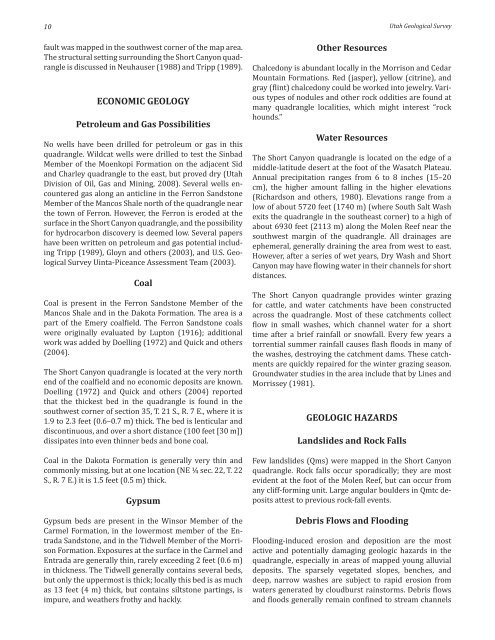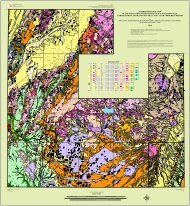download pdf - Utah Geological Survey - Utah.gov
download pdf - Utah Geological Survey - Utah.gov
download pdf - Utah Geological Survey - Utah.gov
Create successful ePaper yourself
Turn your PDF publications into a flip-book with our unique Google optimized e-Paper software.
10<br />
fault was mapped in the southwest corner of the map area.<br />
The structural setting surrounding the Short Canyon quadrangle<br />
is discussed in Neuhauser (1988) and Tripp (1989).<br />
ECONOMIC GEOLOGY<br />
Petroleum and Gas Possibilities<br />
No wells have been drilled for petroleum or gas in this<br />
quadrangle. Wildcat wells were drilled to test the Sinbad<br />
Member of the Moenkopi Formation on the adjacent Sid<br />
and Charley quadrangle to the east, but proved dry (<strong>Utah</strong><br />
Division of Oil, Gas and Mining, 2008). Several wells encountered<br />
gas along an anticline in the Ferron Sandstone<br />
Member of the Mancos Shale north of the quadrangle near<br />
the town of Ferron. However, the Ferron is eroded at the<br />
surface in the Short Canyon quadrangle, and the possibility<br />
for hydrocarbon discovery is deemed low. Several papers<br />
have been written on petroleum and gas potential including<br />
Tripp (1989), Gloyn and others (2003), and U.S. <strong>Geological</strong><br />
<strong>Survey</strong> Uinta-Piceance Assessment Team (2003).<br />
Coal<br />
Coal is present in the Ferron Sandstone Member of the<br />
Mancos Shale and in the Dakota Formation. The area is a<br />
part of the Emery coalfield. The Ferron Sandstone coals<br />
were originally evaluated by Lupton (1916); additional<br />
work was added by Doelling (1972) and Quick and others<br />
(2004).<br />
The Short Canyon quadrangle is located at the very north<br />
end of the coalfield and no economic deposits are known.<br />
Doelling (1972) and Quick and others (2004) reported<br />
that the thickest bed in the quadrangle is found in the<br />
southwest corner of section 35, T. 21 S., R. 7 E., where it is<br />
1.9 to 2.3 feet (0.6–0.7 m) thick. The bed is lenticular and<br />
discontinuous, and over a short distance (100 feet [30 m])<br />
dissipates into even thinner beds and bone coal.<br />
Coal in the Dakota Formation is generally very thin and<br />
commonly missing, but at one location (NE ¼ sec. 22, T. 22<br />
S., R. 7 E.) it is 1.5 feet (0.5 m) thick.<br />
Gypsum<br />
Gypsum beds are present in the Winsor Member of the<br />
Carmel Formation, in the lowermost member of the Entrada<br />
Sandstone, and in the Tidwell Member of the Morrison<br />
Formation. Exposures at the surface in the Carmel and<br />
Entrada are generally thin, rarely exceeding 2 feet (0.6 m)<br />
in thickness. The Tidwell generally contains several beds,<br />
but only the uppermost is thick; locally this bed is as much<br />
as 13 feet (4 m) thick, but contains siltstone partings, is<br />
impure, and weathers frothy and hackly.<br />
Other Resources<br />
<strong>Utah</strong> <strong>Geological</strong> <strong>Survey</strong><br />
Chalcedony is abundant locally in the Morrison and Cedar<br />
Mountain Formations. Red (jasper), yellow (citrine), and<br />
gray (flint) chalcedony could be worked into jewelry. Various<br />
types of nodules and other rock oddities are found at<br />
many quadrangle localities, which might interest “rock<br />
hounds.”<br />
Water Resources<br />
The Short Canyon quadrangle is located on the edge of a<br />
middle-latitude desert at the foot of the Wasatch Plateau.<br />
Annual precipitation ranges from 6 to 8 inches (15–20<br />
cm), the higher amount falling in the higher elevations<br />
(Richardson and others, 1980). Elevations range from a<br />
low of about 5720 feet (1740 m) (where South Salt Wash<br />
exits the quadrangle in the southeast corner) to a high of<br />
about 6930 feet (2113 m) along the Molen Reef near the<br />
southwest margin of the quadrangle. All drainages are<br />
ephemeral, generally draining the area from west to east.<br />
However, after a series of wet years, Dry Wash and Short<br />
Canyon may have flowing water in their channels for short<br />
distances.<br />
The Short Canyon quadrangle provides winter grazing<br />
for cattle, and water catchments have been constructed<br />
across the quadrangle. Most of these catchments collect<br />
flow in small washes, which channel water for a short<br />
time after a brief rainfall or snowfall. Every few years a<br />
torrential summer rainfall causes flash floods in many of<br />
the washes, destroying the catchment dams. These catchments<br />
are quickly repaired for the winter grazing season.<br />
Groundwater studies in the area include that by Lines and<br />
Morrissey (1981).<br />
GEOLOGIC HAZARDS<br />
Landslides and Rock Falls<br />
Few landslides (Qms) were mapped in the Short Canyon<br />
quadrangle. Rock falls occur sporadically; they are most<br />
evident at the foot of the Molen Reef, but can occur from<br />
any cliff-forming unit. Large angular boulders in Qmtc deposits<br />
attest to previous rock-fall events.<br />
Debris Flows and Flooding<br />
Flooding-induced erosion and deposition are the most<br />
active and potentially damaging geologic hazards in the<br />
quadrangle, especially in areas of mapped young alluvial<br />
deposits. The sparsely vegetated slopes, benches, and<br />
deep, narrow washes are subject to rapid erosion from<br />
waters generated by cloudburst rainstorms. Debris flows<br />
and floods generally remain confined to stream channels

















